Day 9: Florence to Venice: "Ready for an Adventure?"
My train didn't leave till late in the morning, so I had plenty of time to stroll around Florence a while, get some supplies, and gawk at the blocks-long line to get into the Accademia to see the real David. I got the shakes and needed a gelato, proving that I was indeed getting hooked on the stuff. Oh well, I enjoyed it while I could since I don't know when I'll be back to have it again.
One thing I did that morning was go to Piazza di San Marco and check out Florence's St. Mark's. It made for quite a comparison to what I would see in Venice.
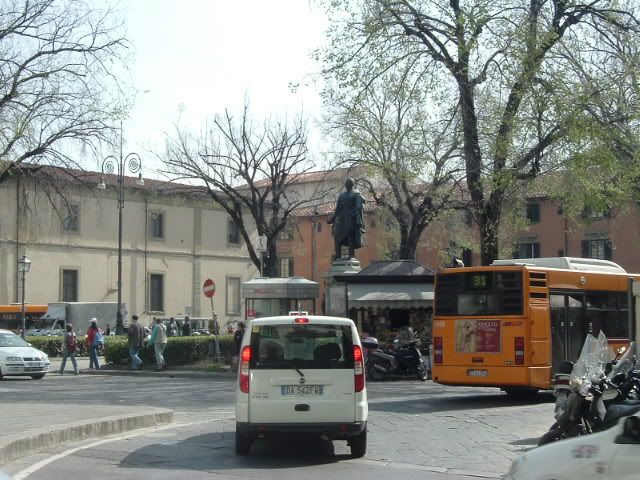
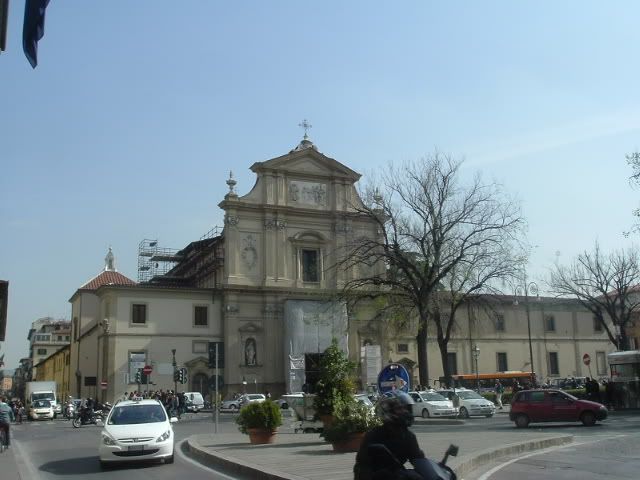
Finally I was on the train, which was fast and fancy, like an airplane. I met some other American exchange peoples who were also touring Europe during their Easter Break (one of 'em even got six weeks off, sheesh). Their tours seemed to include a lot more drunken nights than mine (which is to say "all" instead of "none"). While we chatted and swapped stories of all the wonders we had seen, the train passed through such mythic towns as Bologna (famous for its perplexing lunchmeats), Ferrara (like the car), and Padua (one of the first college towns ever)
Venice soon came into view, and the train had to go over a long bridge before getting to the strange city. Long ago, the Venetians wanted to dodge the incoming Germanic hordes who were stomping all over the place, so they settled in a salt marsh. As they grew, they decided to build by hammering thousands and thousands of upright treetrunks into the deep mud. Surprisingly, it worked. More surprisingly, it has been working for hundreds of years. So, what we end up with is a city whose streets are made of water.

I was to stay at a camp ground outside of Venice (which was much, much cheaper than being in Venice proper), so I only stopped in the city long enough to check out Santa Maria di Nazareth (or just 'Scalzi' as the cool kids call it).

After gaping in awe at yet another beautiful Italian church, I turned to see a sign that read something like, "Remember that these are not pieces in a museum but art in representation of the glory of God." My expression went from amazement to a much deeper sense of wonder. I had gotten caught up in such beauty that I had almost forgot the reason people spent years of their lives crafting them. Wow.
I left the church and headed toward the bus station across the Canal Grande. To get out to the campsite Oro d'Alba (something like "sunrise of gold"), I had to take a bus to the airport, get another bus, and get off at the fourth stop. Even though I was dragging my luggage with me, I still stopped to get a shot of the Grand Canal from Ponte degli Scalzi.
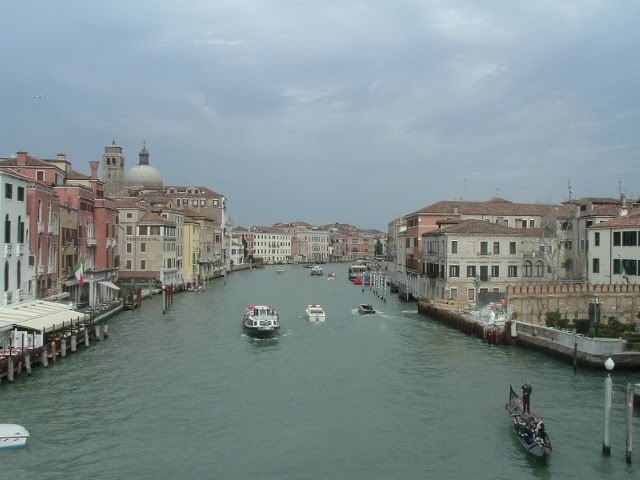
Boats everywhere, man! Venice had boats for everything. Taxi boats, police boats, mail boats, DHL boats, garbage boats, dumptruck boats, and, of course, gondolas. But my mind wasn't on boats, more the landlocked public transit for the Veneto. I followed my directions closely, getting the proper ticket and riding back to the mainland. On the way, however, I saw a sign for the campsite, saying it was only 500 meters ahead. I thought to myself, "Gee, why pay for another bus ride? I can hike that no problem." Then I thought, "Wait, no, I should follow the directions." Then I thought, "Bah, it'll be an adventure. Ready for an adventure?"
So, I got off at the next stop (which was the one just before the airport) and followed the street for what I thought would be a quick walk. After a few hundred meters, the shops and hotels gave way to more country houses. After a few more, I found myself on the autostrade (which is the Italian highway, fast cars and crazy drivers). It was then that I saw another sign pointing to the campsite, assuring me it was just around the next bend at one kilometer this time. I hiked for an hour or more, carrying my rolly-bag since there wasn't ground enough for its wheels to work in the grassy ditch (and there was no way I was going to hang out near the traffic). Strangely, despite the "no pedestrian" signs, neither of the police cars that passed me seemed to mind. Just as I gave up hope and decided to resort to self-canibalism, the campground itself appeared, and I was safe for the night.
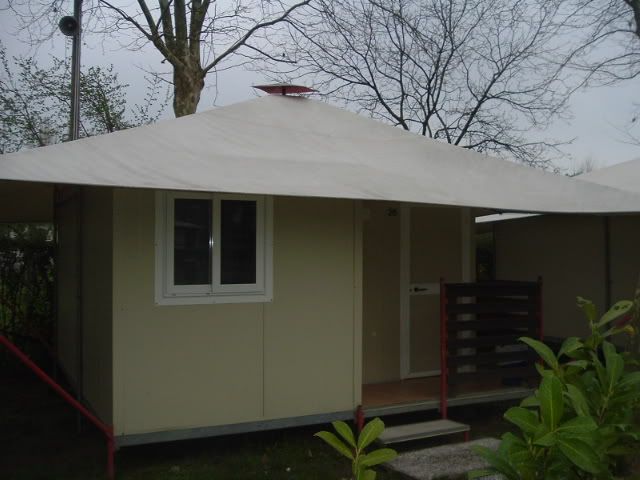
Except I had to switch tents twice since the first had a broken lock and the second was covered in ants, and it was a long walk to the bathroom. Plus, there was the thunderous roar of airplanes taking off from the airport. Still, better than being huddled in the cold night, lost and chased by Italian wolves or paying to stay in Venice. I cranked up the heater, read, ate the rest of my groceries, and went to sleep, dreaming of what adventures may come.
Day 10: The World just looks better with Gelato in your Tummy
A loud rooster crow woke me up at about 6 the next morning, and I was reminded of why I didn't miss having chickens on the farm. I dragged myself out of bed, got cleaned up, and headed out to catch the bus to Venice (I learned my lesson, heh). While I was waiting at Marco Polo airport, the misty clouds above grumbled and decided to rain. And I do mean rain. It poured like the sky was bleeding. I felt sorry for the girls in the tent down from mine who had gone out jogging.
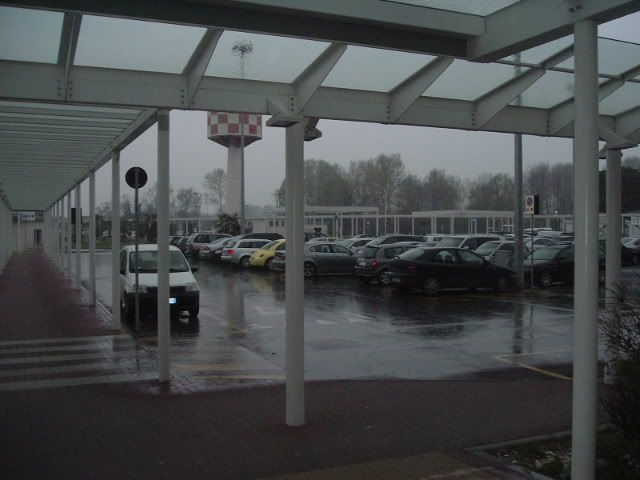
Despite the weather, I pressed on. It seemed that almost no one pays for public transportation in the Veneto (except us ignorant tourists, of course). The lady who sat next to me on the bus was reading an Italian devotional from Matthew. She was also one of the few to stamp her ticket, which I thought was cool. The ride was kind of long, but at last we arrived back in Venice, and I plunged out into the drenched, twisty alleyways of Venice.

My shoes were soaked within the first three minutes, and my socks continued to absorb water throughout the day. On top of that, some of the alleys were too narrow for umbrellas, making me wish I had gone back for my hat. But, I was in Venice, and no mere threat of hypothermia and pneumonia was going to stop me.
Besides, everyone has pictures of Venice in the sun. I have it dark and wet.
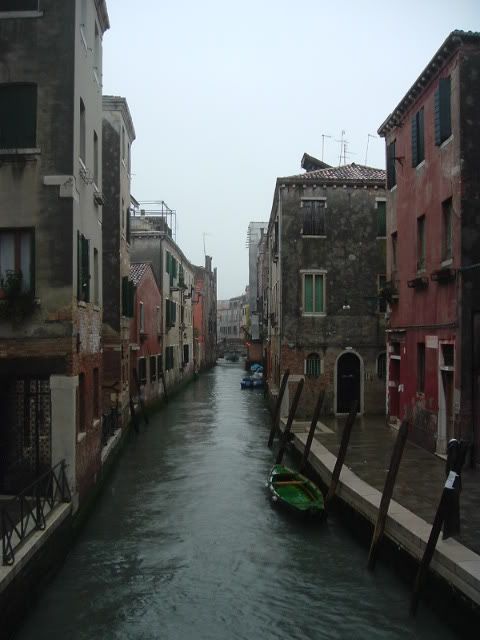
Venice didn't have much in the way of graffiti. There were lots of posters, especially about the up-coming election.

What Venice did have were a lot of localized smells, making one's nose tingle as the air went from salty to fresh to stinky to sweet (near the candy shops) to mind-numbingly putrid at the fish market.
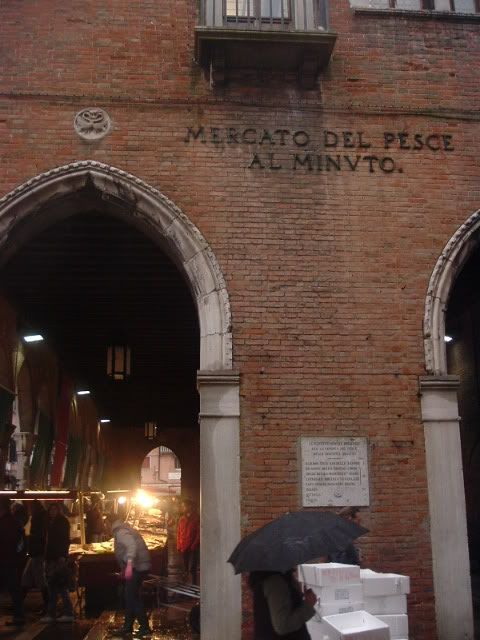
But the architect had a cool idea of making the columns have little fish heads.
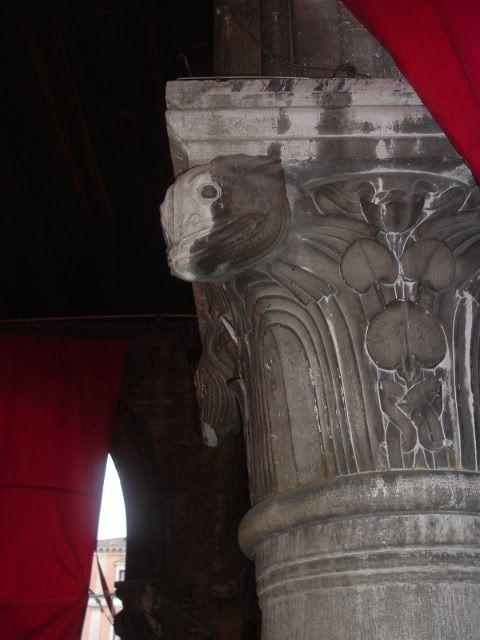
My first stop (since it was the nearest, and I was half-frozen and soaked) was the Natural History Museum. Along the way, I got well-acquainted with the madness of Venetian streets, and I saw that I'd either need to keep a close eye on the map or toss it out altogether. So often confused, I finally decided, "It's physically impossible not to get lost." The museum was cool, though it only had two rooms: a big aquarium and a room dedicated to some dinosaur digs in the Sahara. Fish and dinosaurs, what more do you need? How about a nifty plaza inside?
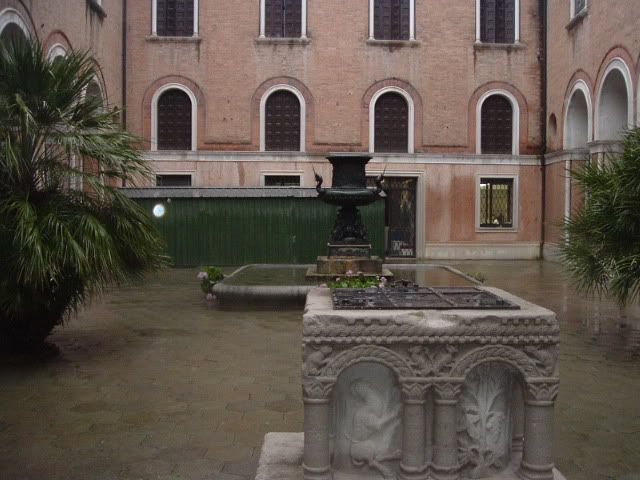
They did have a skeleton of a 37-foot prehistoric crocodile, which was stunning in bestial magnitude. That thing could've grabbed a whole human in its mouth. I'm glad it's extinct.
After the museum, I faced the weather again and walked southeast toward the fabled San Marco Square. Along the way, I passed Ca d'Oro, which means The Golden House. Venetians say "ca" instead of "casa", though I'm not sure whether it's out of laziness or just being cool or both.

Despite the lack of vegetation and space, Venice still had piazzas everywhere, I guess to give the residents a place to stretch their legs. Going up and down the stairs at the bridges was giving me quite a stretch.
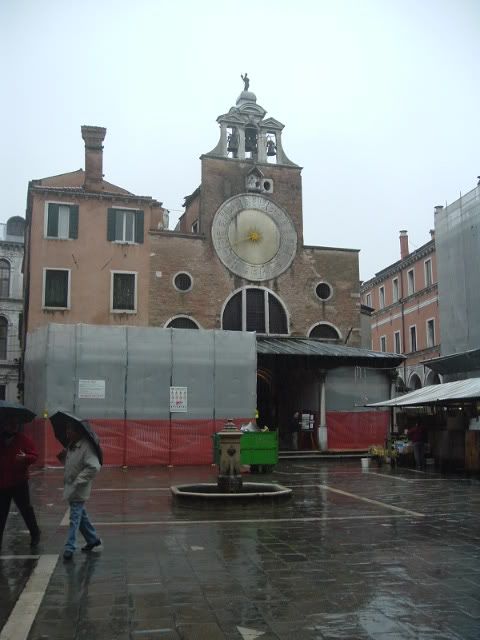
There was also this little outdoor podium, but I couldn't find out any information about it. Was it for preaching? Was it for inciting riots? Was it just for show? I may never know.
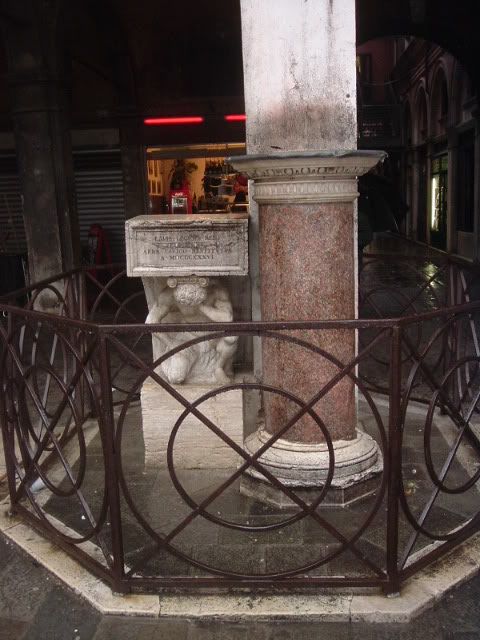
I eventually came to the famous Rialto bridge, which is packed with pricey shops and tourists. They chose well, as it is one of the prettiest bridges in the bridge-filled city.
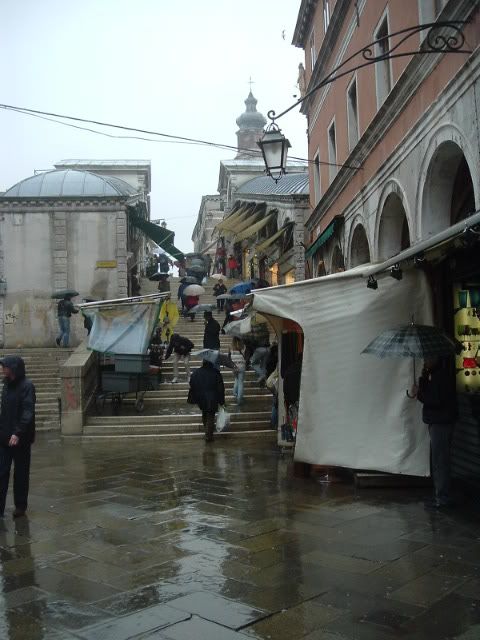
Venice also has its share of statues (and you know how I like statues). This one's of the writer Goldini, known for his satire and jokes (or so the guidebook said).
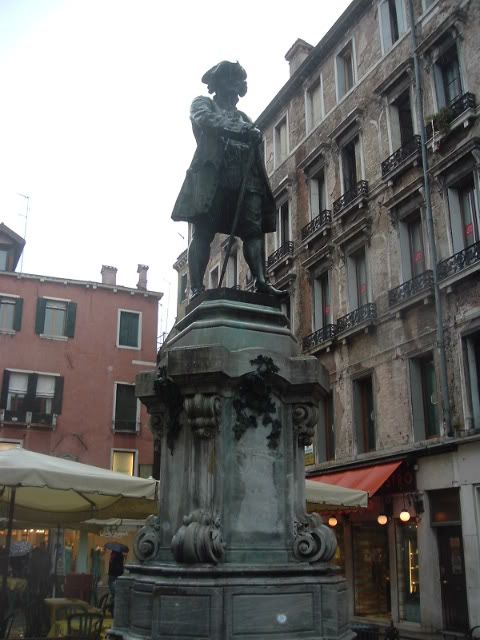
Ah, yet another neat little alleyway with mask shops. Venetians love masks.

Eventually I ended up in the rain-soaked Piazza San Marco. Despite the rain, the tourists were still out. They're a tough breed.
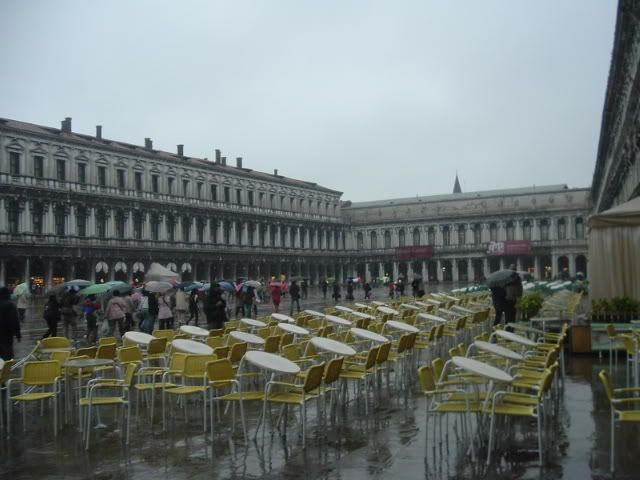
The cathedral of San Marco is... looming.
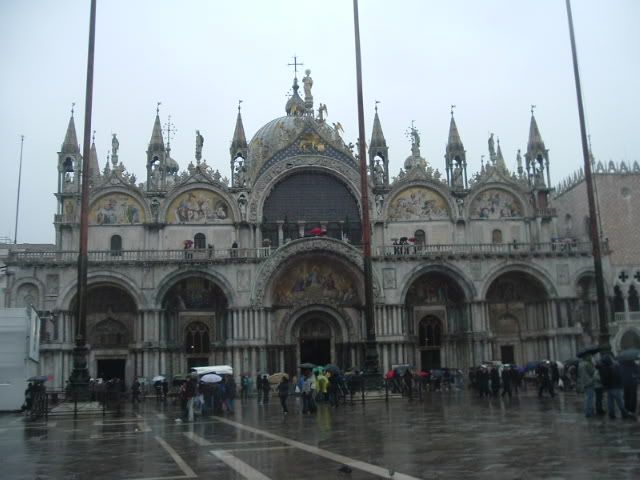
And the campanile is even more looming. This is not the original, however, as that one fell suddenly in 1902 after foundation problems.
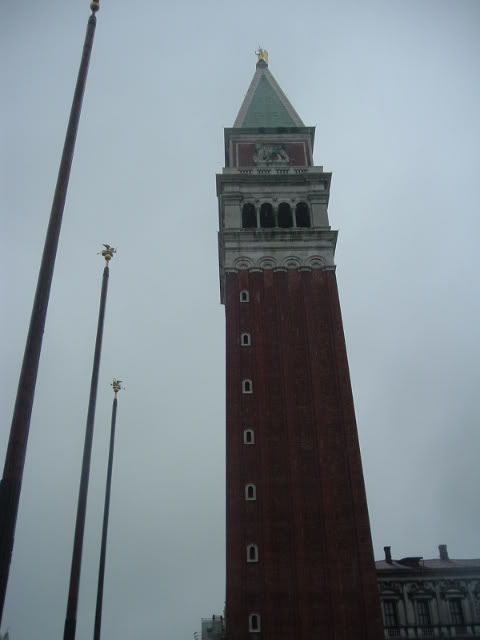
San Marco is probably best known for its pigeons, who were also out braving the weather. They were everywhere, filling the crowd with laughter and screams. It seems some people are deathly afraid of pigeons, which made the square a living nightmare. Everyone else looked like they liked it fine.
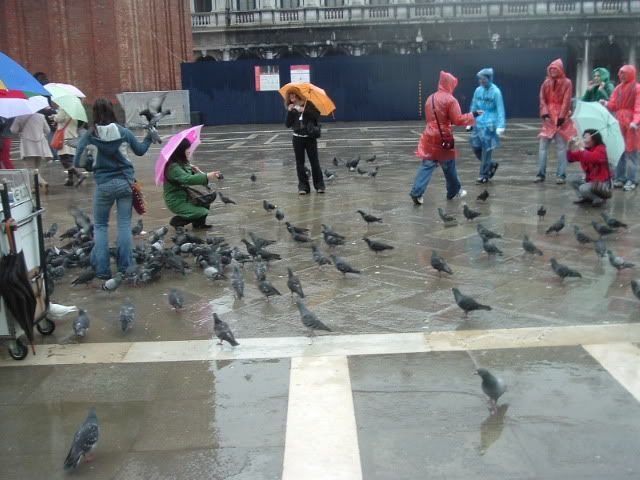
Around the corner is the Doge's Palace, where the Venetian government met.
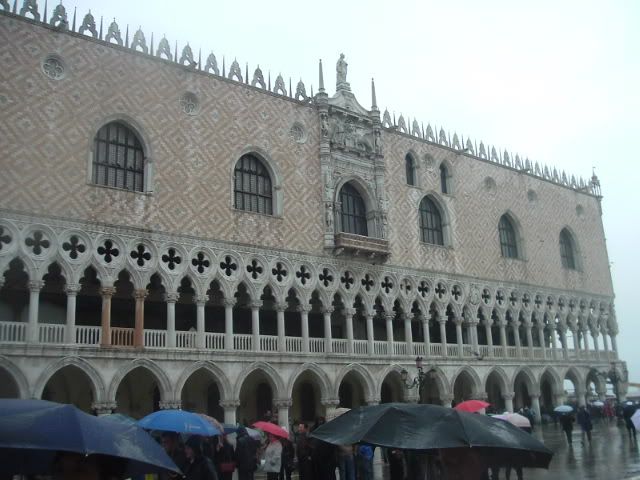
And looking out into the harbor gives us a view of Sts. Mark and Theodore (who was the old patron said of Venice before Venetian merchants smuggled the remains of St. Mark out of Muslim Egypt). The symbol of St. Mark is a winged lion. That's a great idea: Let's take the savanna's most powerful killing machine and give it the ability to fly.

And here's me at the Bridge of Sighs (which was indeed much better than the one in Oxford, tsk tsk). I'm sighing after seeing the long lines waiting to get into the palace.

Since it was so packed, I decided to come back earlier the next day. Instead, I headed off to find a gelateria and get my daily fix. Once I finally found one open, I ate up and my outlook improved. Rejuvenated by super-ice-cream, I checked out church after church and plenty of statues.
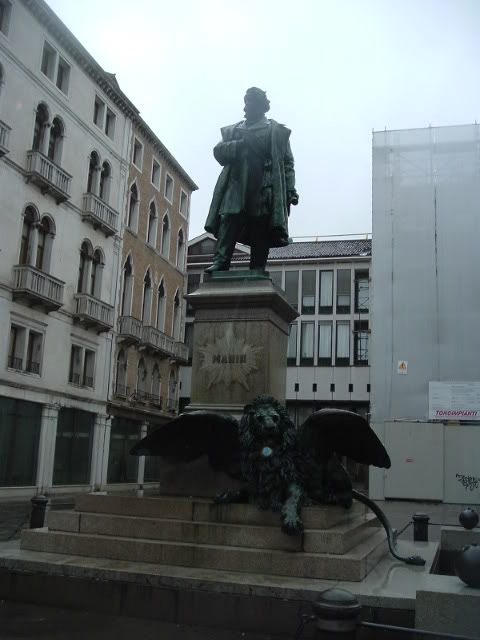
Venice has a leaning tower, too. I tried to get over to it to check it out, but my map and the Venetian streets seemed to change whenever I wasn't looking.
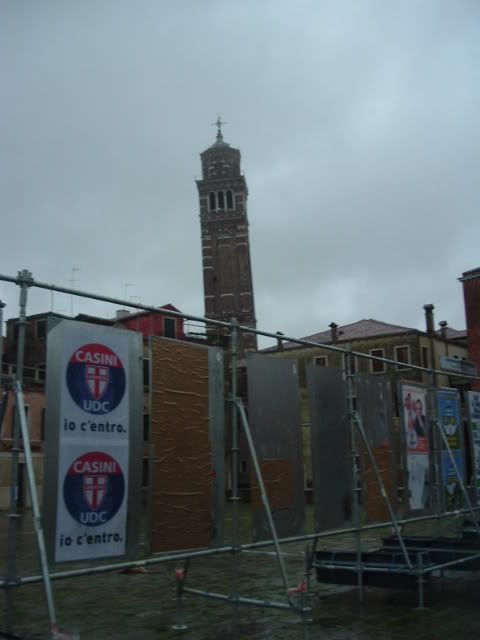
I did, however, stop at the Accademia, which is Venice's big art museum. It was free, mostly warm, and dry, so I spent most the afternoon there, basking in the glow of 18th century art. By the time I convinced myself to leave, the rain had stopped, though the wind had come up a lot. But the day was young and so was I, sending me out into the streets where I saw things such as a lamp made out of glass umbrellas and a dragon.
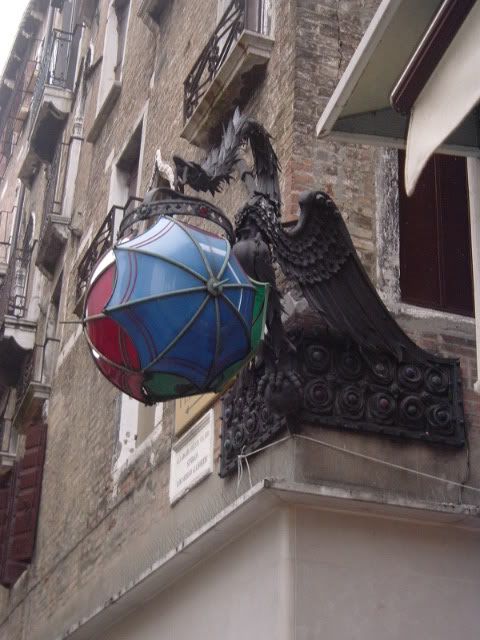
And here's the Rialto bridge from the side, looking all white against the gray sky.
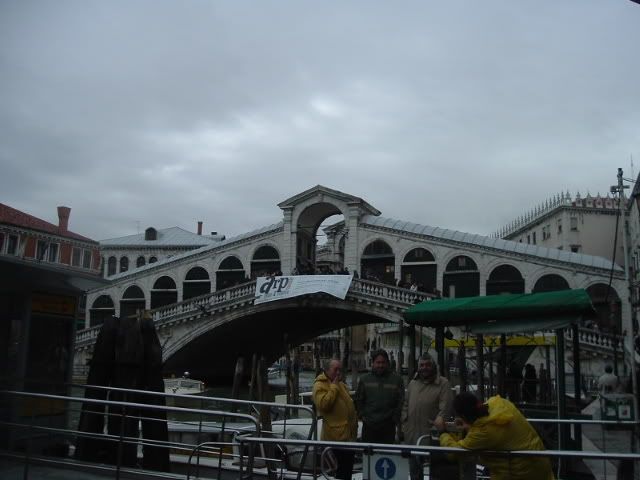
And here's me. If you'll notice, my eyes aren't exactly in sync due to exhaustion.
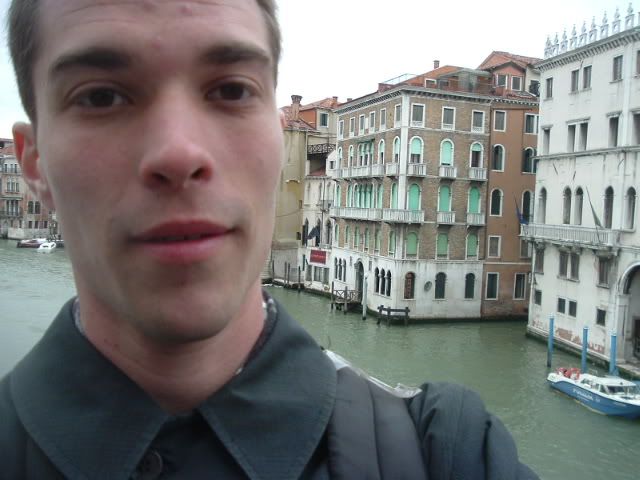
I passed by some taxi boats and police boats. They're so cool.
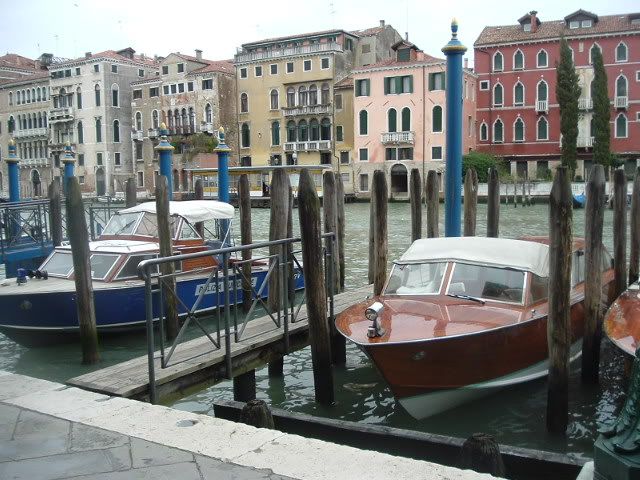
And I even went to see the Fortuny museum, which was I guess some artist dude in the early 20th century. It wasn't overly impressive (especially after the Accademia), though it did have a cool eisel with a built-in seat and a collection of photographs from around Venice in 1902 or so. I gaped when I saw the pictures, since Venice looked exactly the same over a century later. Wow.
The next stop was the Telecom Italia Future Centre, which was put up in 1999 as a demonstration of the wonders of technology to come. I laughed my head off when one of the ladies told me that most of the equipment was broken. I laughed even harder when I saw the Compaq computers (which, for those of us less nerdy, aren't made anymore since Compaq and HP merged). Still, it was a very interesting exhibit with a little data card that you programmed at the beginning with name, interests, and what language you speak, so that all the machines could tailor their information for you. I learned about Marco Polo and voice synthesis, which they said was born in the mid-'70s in Italy. They also had a room full of futuristic (and now way, way old) video games such as Call of Duty and Jedi Knight II. But, since it was still Lent, I didn't play any.
By this time it was getting pretty late, so I decided to head back toward the bus station in a meandering path on the north side of the Grand Canal. I liked the north side better, though I'm not sure why. Maybe it seemed more local and not quite as touristy as the south. Or maybe it's because it had a cool mossy staircase.
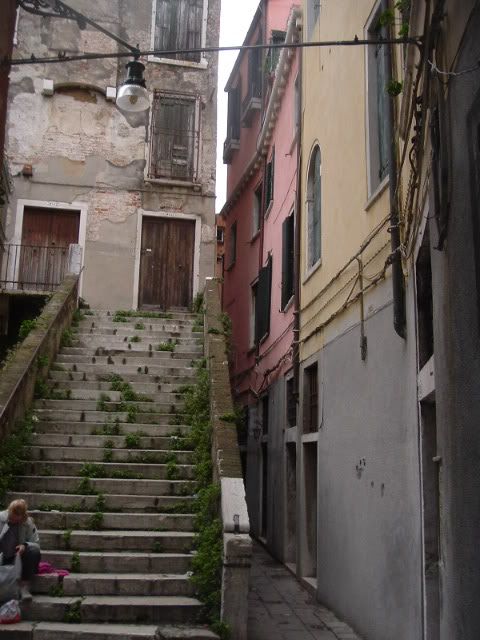
It even had a supermarket, where I got some food for dinner and lunch the next day and joked with an old American couple in Venice on vacation. Then it was a ride back on the bus, a big dinner next to the heater, and an early night in bed.
Day 11: Streets of Gold
The rooster woke me again, but, after glancing at the exceedingly early time on my alarm, I went back to sleep. When I woke up again, I remembered the alarm was still set to London time, which is an hour slow. Swiftly panicking and then swiftly realizing that I wasn't really on a schedule anyway, I headed out to Venice a little later than I planned.
As if in apology for the rain the day before, the wind blew through in the morning, clearing away all the clouds and then dying to a nice sea breeze. It was the perfect weather to start a cruise down the Grand Canal on a vaporetto (which is kind of a bus-boat).

I picked it up by the bus station, which is about the farthest northwest corner and rode all the way down to St. Mark's in the southeast. Of course, the path has quite a few bends, but, hey, that's just more palaces I get to check out. Palaces like Ca d'Oro in the sunshine this time.
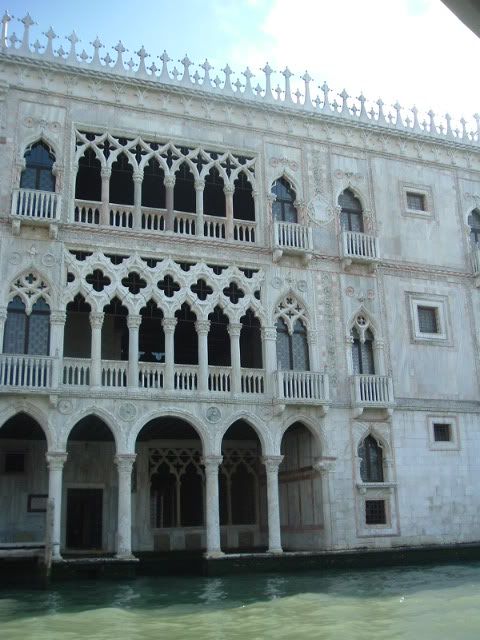
We passed under the Scalzi bridge, where I had my first peek at the strangeness of Venetian canals. In the bright morning sun, the water glistens, making it look like the city is paved with gold. It's jaw-droppingly gorgeous.

We passed a lot of very interesting things, like the palace where Napoleon hung out whilst conquering Italy.
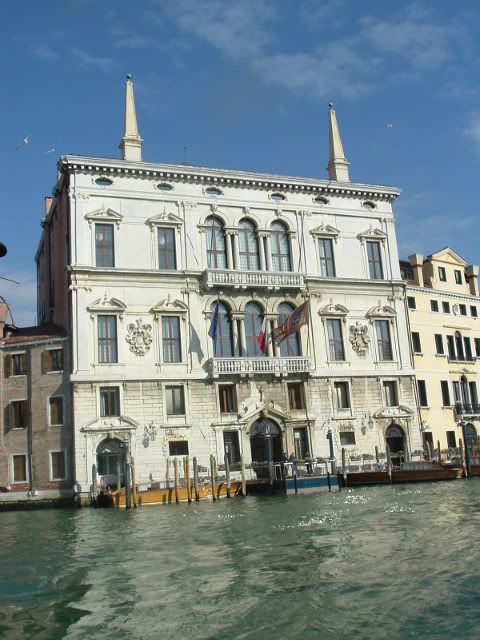
And a parcel-delivery boat.

And dozens of Japanese tourists in gondolas. Hehe.
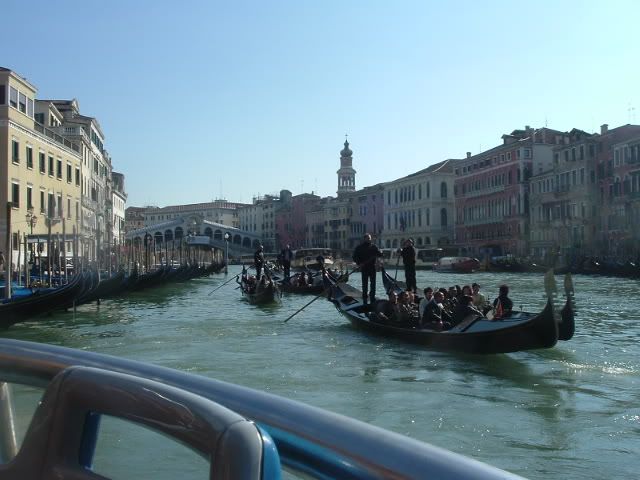
The city is so nice from the water-level. On foot one can get caught up in the twisting alleys and miss a lot, but in the open, there's so much to see.
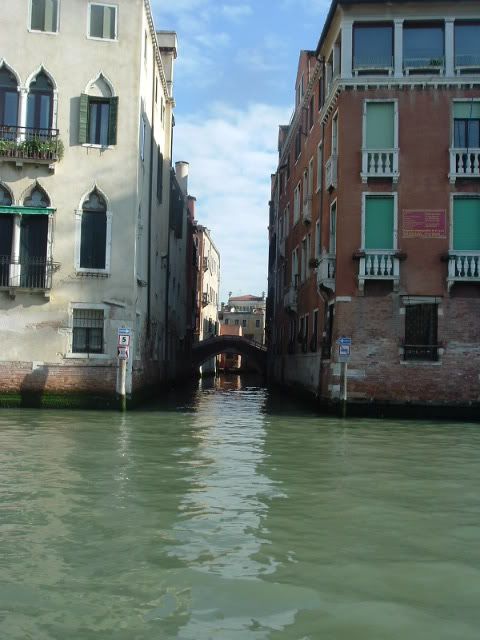
Oh, and here's the Rialto in the sunlight. Much better than the frigid rain.
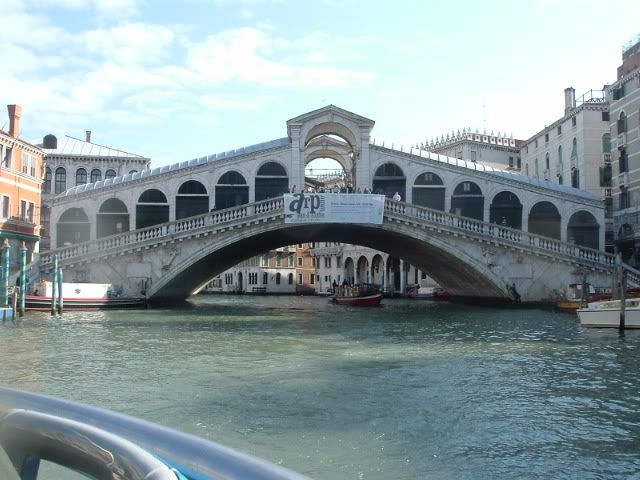
And here's a partly wooden bridge that was put up in the '30s as a temporary replacement, but the people liked it so much that they voted to keep it. One of the few things to change in Venice since 1902, I guess.
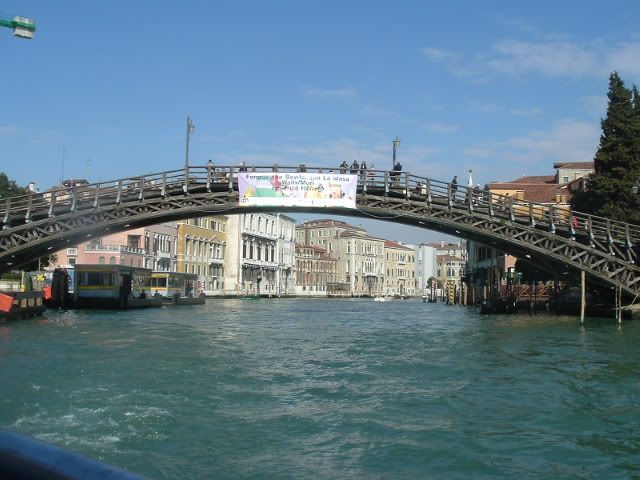
Toward the end of the Grand Canal and on the opposite side to St. Mark's Square is the Santa Maria della Salute. It's a very pretty church from the outside, and I regret not having time to get inside. Oh, well, maybe I'll just have to go back someday.

Just beyond Santa Maria is the Dogana di Mare, where the Venetian government took in their taxes from shipping. It was once one of the biggest money-makers in the world.
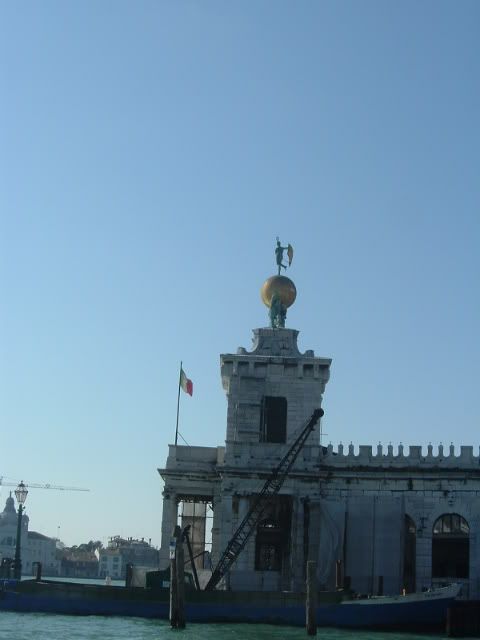
I got off just before St. Mark's and walked through some gardens. The square looked even better when I wasn't soaked and freezing.
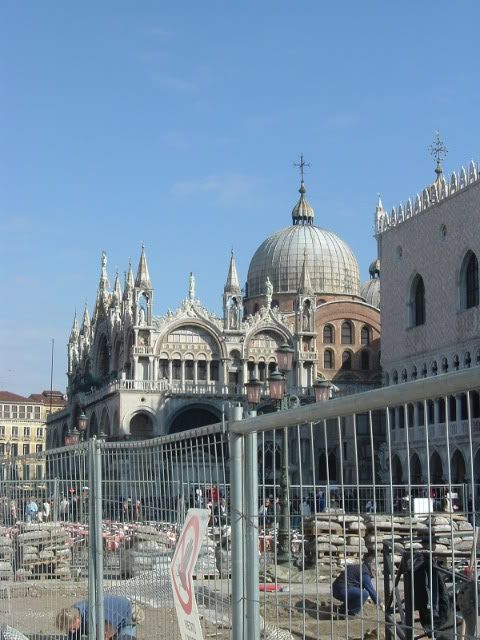

There's the Bridge of Sighs, but I ain't sighin' this time!
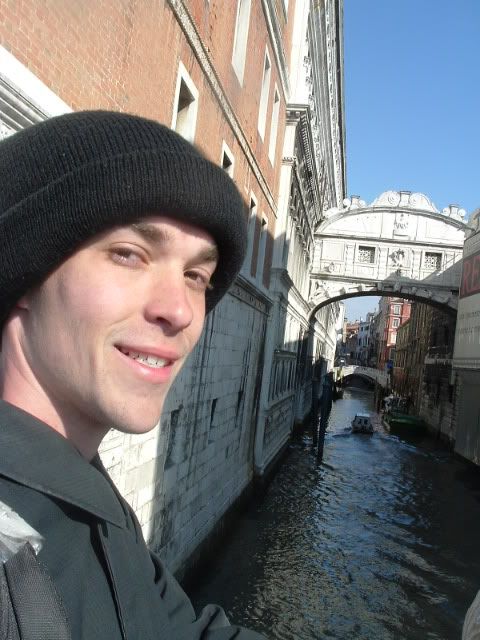
My first stop was the Doge's Palace. After squeezing through the tour groups to the individual's entrance, I came out into the piazza in the center of the building. Not a bad way to have your backyard look.
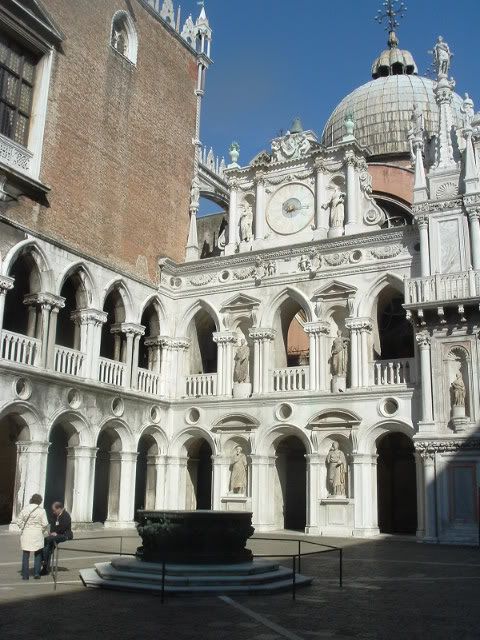
A little farther on is the Giant's Staircase, where the doge and other higher-ups are presented. I'm pretty sure the statues are Mars and Neptune, which fit for a naval city. When you stand at the top, like the doge would, you see other statues of Adam and Eve, which make for a reminder of human imperfection, even a doge.

From the courtyard, one goes up the Golden Stairs to the first floor (American translation: second floor) where the doge lived and worked. It's a sweet staircase.
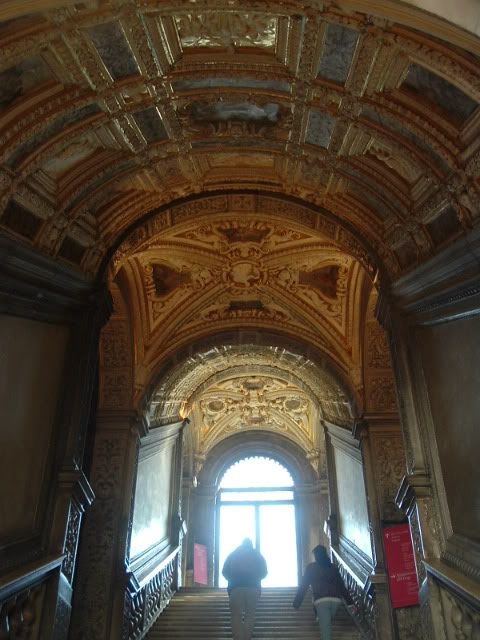
Unfortunately, pictures aren't allowed inside. If you try to take them, one of the docents will clap her hands at you and say, "No photo!" It's really too bad, since they have the doge's living spaces (pretty cool), the senate and committee rooms (very nice; the senate hall is one of the biggest single rooms in Europe), an armory, and a really cool map room with two giant 17th century globes. Mm, map rooms. Once you go through all that and then the halls of justice, you cross the Bridge of Sighs to the prisons (which are just yards from the highest office, perhaps even close enough to hear the wails of the tortured).
After all that opulence, the jail looks like extreme squalor with low ceilings, darkness and chill, and plenty of prison graffiti. There is an exercise yard at least, with a gate leading outside. It's now an emergency exit, but they keep it locked with the centuries-old key safely in a glass box.

When the prison tour is complete, you cross the Bridge of Sighs back into the palace, following the footsteps of countless prisoners. Through the window, you get your last look of freedom at the sunny harbor beyond. I sighed, too, since I had seen all the palace had to offer.
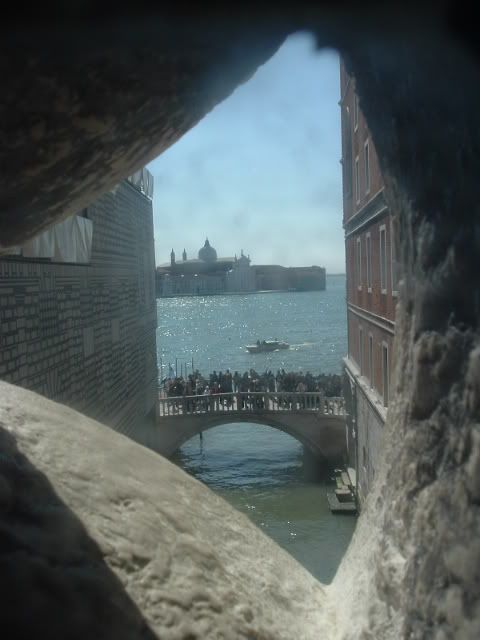
Next up was St. Mark's, which was about as Byzantine as anything I've seen.
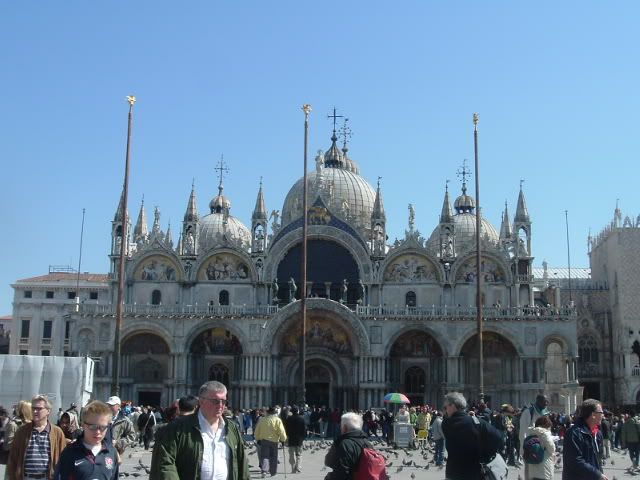
Inside, the walls are covered in gold and mosaics and frescoes and more gold. They have lots of little museums for the treasury and things, and they even have the original four bronze horses that the Venetians stole from Constantinople as the Crusaders sacked the Christian city.

You can also climb to the top (just beside the new horses put out for show) and get a great view of the square and some of the city beyond.
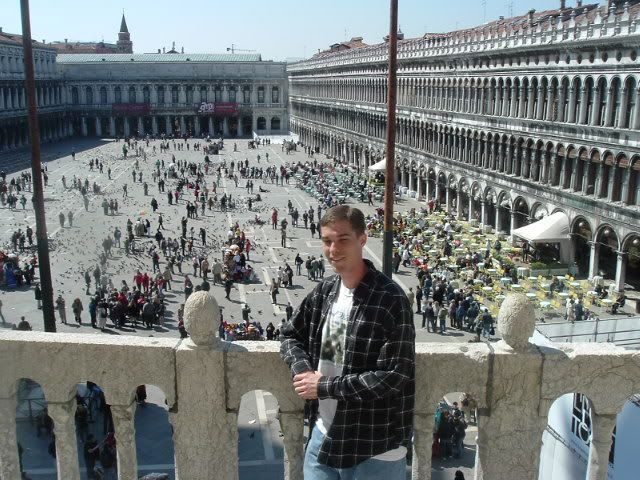
Then you can walk around to the other edge and see how St. Theodore and St. Mark look in the sunlight from above.
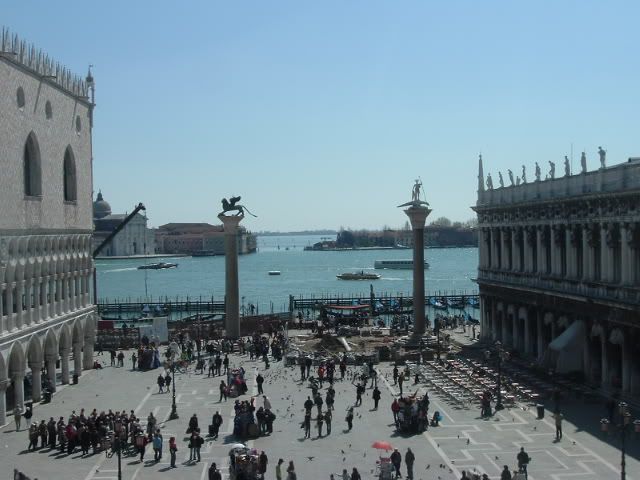
And, best of all, one of the saints in the alcoves outside is Santa Claus! He looks surprisingly similar to his Coca-Cola counterpart.
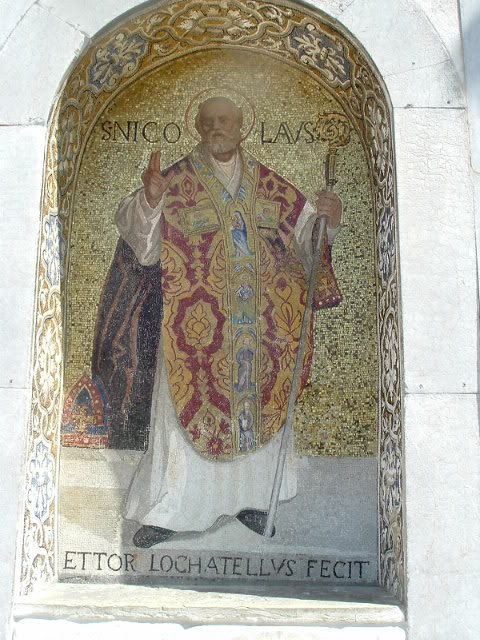
I hung out on top of St. Mark's for a while, soaking up sun, but eventually I had to move on and pick up my bag from the coatcheck. Besides, there was still plenty to do, such as check out the archaeological and Venetian history museums, the library (perhaps third coolest library I've ever seen), and get my daily gelato fix. It was the last gelato I would have, and I did my best to savor every bit. Looking back, I think Rome had the best gelato. The next day, it was tough going cold turkey on the ice cream, but I did all right once the shakes subsided.
Then I settled into wandering through the city to find the Ponte di Pugni, one of the places where Venetians would meet for a strange, strange holiday. The guys would gather into teams by neighborhood, meet at the bridge, and then pummel the ever-living petunias out of each other in a titanic game of king of the mountain. The starting points are marked with footprints in the bridge.
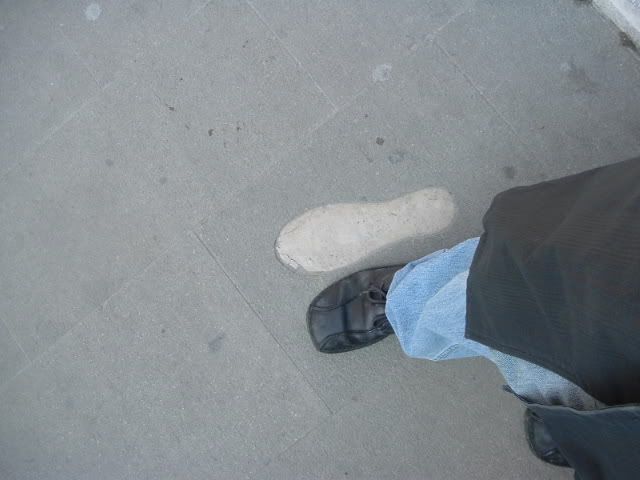
After reflecting on the bizarre beating festival, I checked out the gardens of Ca' Rozzonico and walked through the peaceful neighborhoods on the southwest side (you know the kind, where laundry hangs out in the sun and kids walk happily home from school). Eventually I ended up at the train station, where I saw some Native American performers. Hm, unexpected, but entertaining.
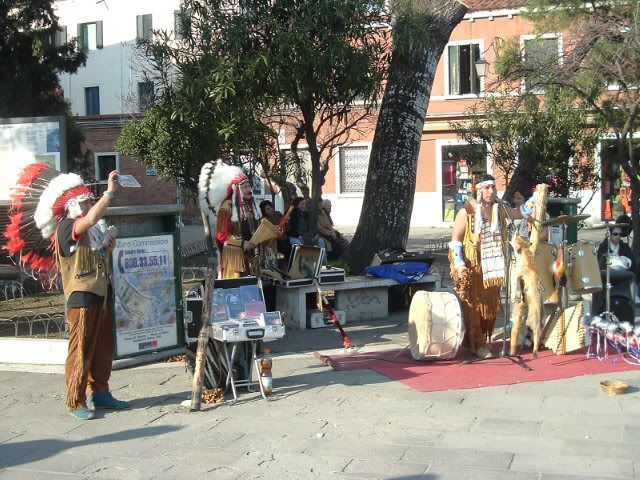
I stood in line for a long while and got my ticket to Zurich sorted out. I was surprised that there were so many jerks in line, sliding ahead of me whenever possible. Ugh, impolite.
With the last few hours of daylight and my ticket in hand, I headed out for a look at the Jewish ghetto. It was pleasant and kosher, if cramped. Still, the atmosphere was very friendly and I passed by old men discussing philosophy and young mothers out with their kids. Best of all were the boys playing soccer in the square in front of the Holocaust memorial, without a care in the world.
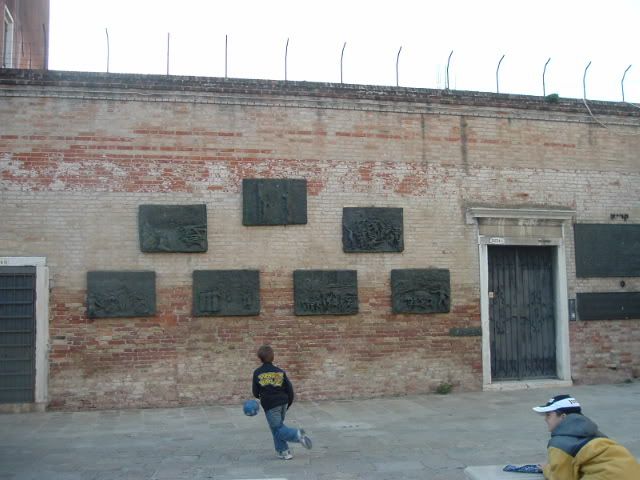
Wow, that's probably my favorite picture out of the whole trip. To have a people forced into ghettos for centuries and then nearly exterminated in the Holocaust, yet their children happily play on... awesome.
The sun was beginning to set, so I headed back toward the bus for a final long ride back. But, I couldn't leave before snapping a couple more pictures of canal-streets.
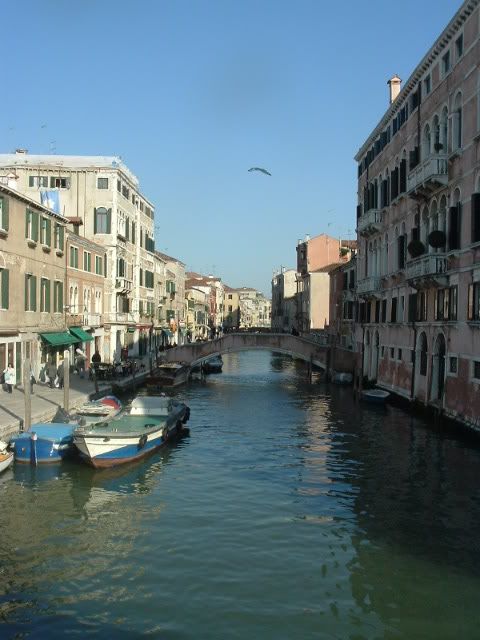
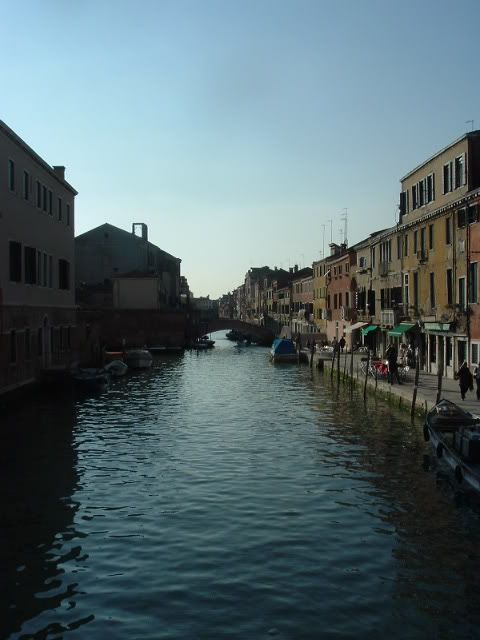
My last view of Venice for the day was a cluster of gondolas in the sunset with their gondoliers in the background, chatting and waiting for the sweet nighttime to take tourists for a cruise.
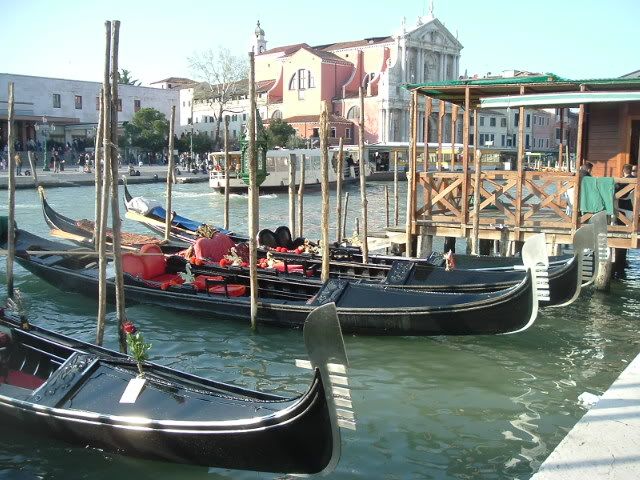
Back at the camp ground, I visited the restaurant for a bit of spoiling myself with a tasty lasagne. It wasn't an American-sized portion, but surprisingly filling, and I totally slept well that night. It's a good thing, too, for tomorrow would be a big day.
Back to Jeff's Weblog






























































